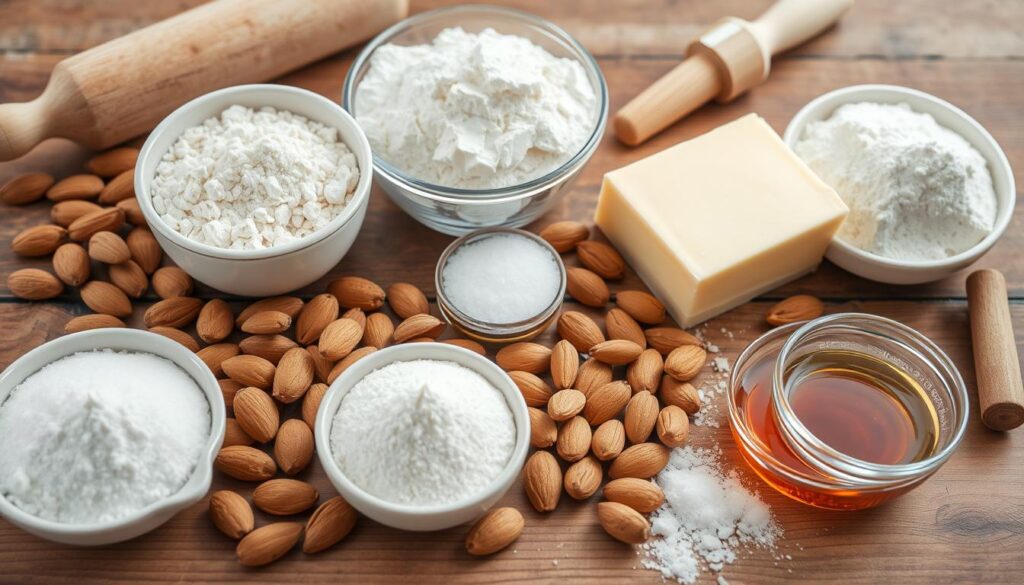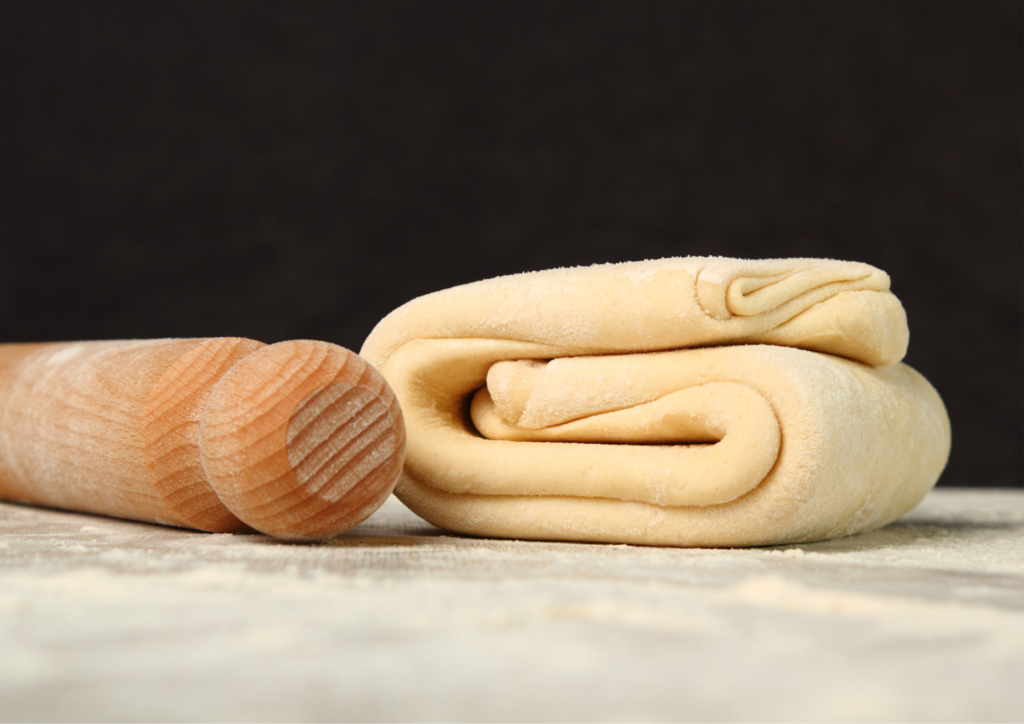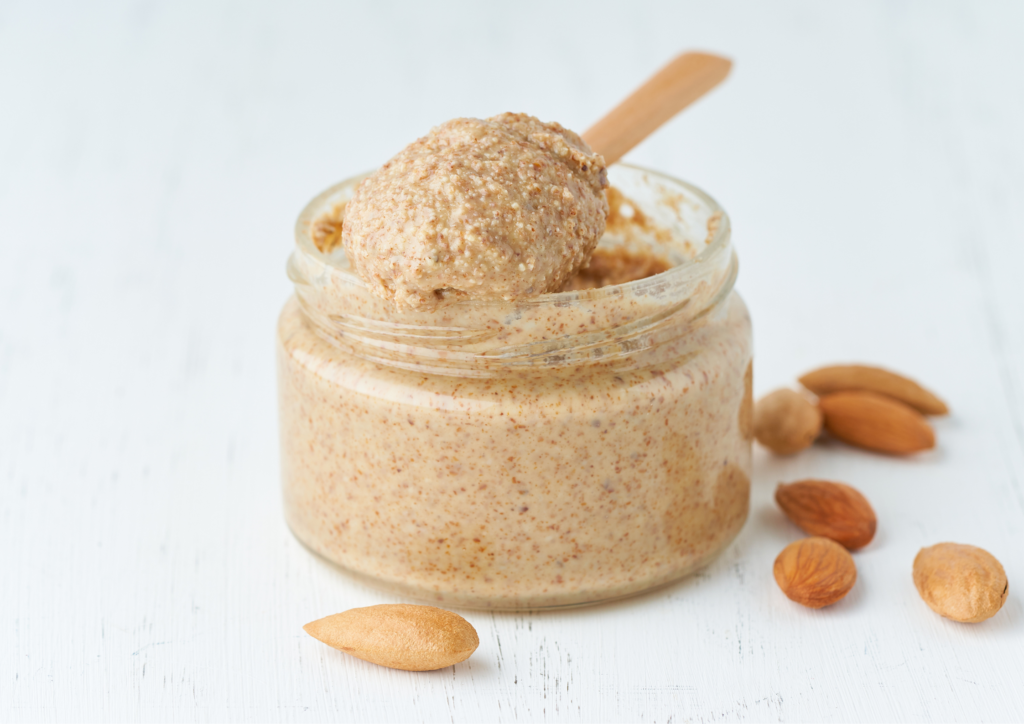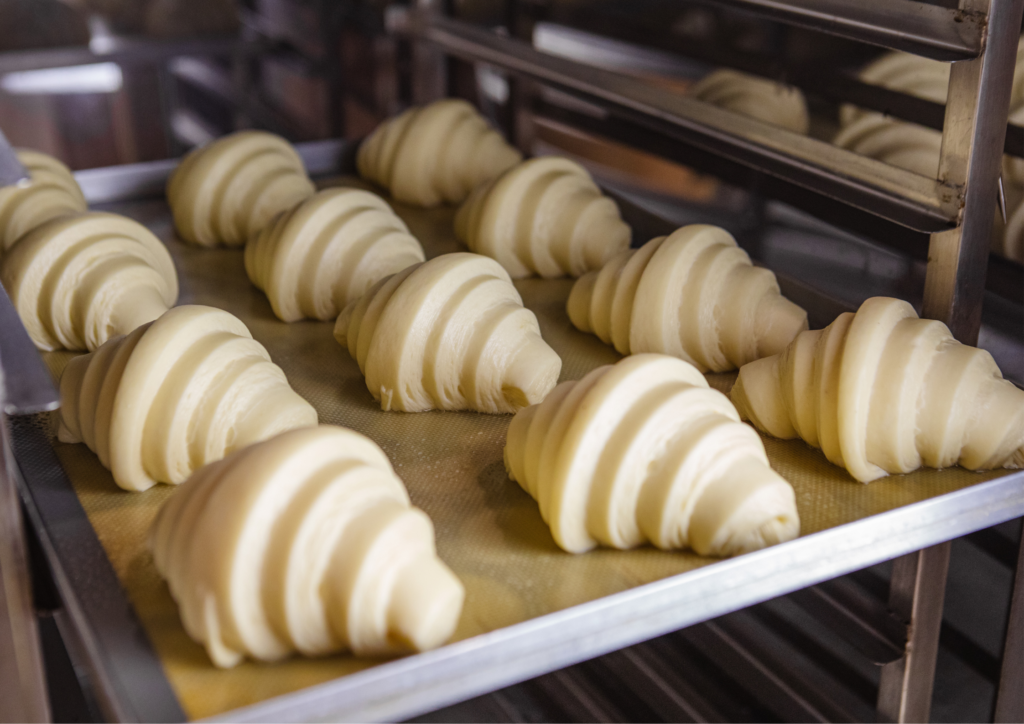Did you know that over 2 million croissants are eaten every day in France? This French pastry has won the hearts and taste buds of people everywhere. Now, you can make your own delicious almond-filled croissants at home.
Imagine the smell of freshly baked, flaky croissants filled with creamy almond cream. It’s a true French treat that you can enjoy anytime.
Table of Contents
The History and Origins of Classic Almond Croissants
The almond croissant is a beloved French pastry with a rich history. It dates back to the 19th century. This treat has grown from a simple croissant to a cherished part of French patisserie.
French Patisserie Heritage
The croissant is a symbol of French baking. It has flaky layers and a crescent shape. It started in Vienna, Austria, but French bakers made it famous.
This passion for pastry is a big part of French culture. Each region and bakery has its own twist on the croissant.
Evolution of the Almond-Filled Version
The almond-filled croissant came in the early 20th century. Bakers tried new fillings to create exciting flavors. The almond cream, or frangipane, was a hit, making the croissant rich and indulgent.
Traditional Recipe Origins
The exact origins of the almond croissant recipe are a secret. But, it’s believed to have evolved over time. Each patisserie has made their own version of this iconic treat.
Today, the almond croissant shows the lasting legacy of French pastry. Its history is tied to French culture. From Viennese beginnings to today’s artisanal creations, it delights pastry lovers everywhere.
Essential Ingredients for Perfect Almond Croissants
Making the perfect almond croissants needs top-notch ingredients. At the core of this French pastry are a few key elements. They make it melt in your mouth and taste rich and buttery.
High-quality butter is crucial. Choose a European-style, unsalted butter with lots of fat. This will give you a flaky, golden-brown outside and a soft, indulgent inside.
Almond flour and pastry flour are also vital. Almond flour adds a sweet, nutty taste and a luxurious feel. Pastry flour helps get the right mix of structure and lightness.
Using vanilla extract wisely can also boost the flavors. It adds a subtle depth and complexity to the almond croissants.
| Ingredient | Importance |
|---|---|
| High-quality butter | Provides the signature flaky, buttery texture |
| Almond flour | Imparts a rich, nutty flavor and luxurious mouthfeel |
| Pastry flour | Helps achieve the perfect balance of structure and lightness |
| Vanilla extract | Adds depth and complexity to the overall flavor profile |

Professional Tools and Equipment Needed
Making delicious almond croissants at home needs the right baking tools and pastry equipment. You’ll need the basics, but advanced tools can make your croissants even better.
Must-Have Baking Tools
- Sturdy baking sheets or trays
- Rolling pin for handling the dough
- Silicone baking mats or parchment paper
- Sharp chef’s knife or bench scraper for cutting the dough
- Mixing bowls and a handheld mixer or stand mixer
- Measuring cups and spoons for accurate ingredient portioning
Optional Equipment for Advanced Techniques
If you’re looking to try more advanced pastry equipment, here are some tools to consider:
- Dough sheeter or pastry rolling machine for easy dough lamination
- Pastry brushes for applying egg wash or melted butter
- Offset spatula for delicate dough handling and shaping
- Pastry bags and tips for piping the almond cream filling
Temperature Control Essentials
Keeping the right temperature control for baking is key for perfect almond croissants. Make sure you have these tools to manage the temperature:
- Oven thermometer to ensure accurate oven temperature
- Refrigerator and freezer thermometers to monitor chilling and proofing temperatures
- Instant-read thermometer for checking the internal temperature of the baked croissants
With the right baking tools and pastry equipment, and precise temperature control for baking, you can make amazing almond croissants at home.
Understanding Laminated Dough Techniques
Making delicious almond croissants needs skill in laminated pastry dough. This dough, also known as puff pastry, has butter layers between thin dough sheets. It makes the croissant flaky and crispy.

The secret to great laminated dough is in dough folding and butter layering. By adding butter carefully and folding the dough, layers form. These layers puff up when baked, giving the croissant its special laminated pastry feel.
- Start with cold, pliable dough and firm butter.
- Put the butter inside the dough, making a sandwich.
- Roll out the dough, keeping it rectangular and even.
- Fold the dough in three, like a letter, to make layers.
- Roll and fold again, resting the dough in the fridge between folds.
- This process turns the dough into a flaky, amazing pastry.
Learning laminated dough is key to making amazing almond croissants. By mastering these techniques, you can bake like a pro in your kitchen.
Making the Rich Almond Cream Filling
Take your homemade almond croissants to the next level with a luscious almond cream filling, or frangipane. This filling is key to balancing the buttery pastry with a rich, nutty taste.
Preparing Frangipane
To make the frangipane, you’ll need a few ingredients:
- Unsalted butter, softened
- Granulated sugar
- Eggs
- Almond flour or finely ground almonds
- All-purpose flour
- Vanilla extract

Begin by creaming the butter and sugar until light and fluffy. Next, add the eggs one at a time. Then, mix in the almond flour, all-purpose flour, and vanilla extract. Keep mixing until everything is well combined and smooth.
Cream Storage Tips
The almond cream filling can be made ahead and stored for up to 5 days in the fridge. Just cover it tightly with plastic wrap. When you’re ready, scoop it into your croissant dough before baking.
Consistency Guidelines
The frangipane should be thick enough to hold its shape but still easy to work with. It should feel like a thick pastry cream or whipped frosting. Adjust the flour and almond flour mix to get the right consistency for your croissants.
Step-by-Step Croissant Dough Preparation
Making croissant dough from scratch is a fun and rewarding process. We’ll guide you through each step, from yeast activation to kneading. This will help you create a delicious croissant dough.
Activate the Yeast
Start by activating the yeast. Mix warm water, sugar, and yeast in a bowl. Stir gently and wait 5-10 minutes for it to become frothy. This shows the yeast is alive and ready to work its magic.
Mix the Dough
In a big bowl, mix flour, salt, and the yeast mixture. Use a spoon or your hands to mix until it forms a shaggy dough. Make sure to get all the flour from the bowl’s sides.
Knead the Dough
Put the dough on a floured surface and knead for 10 minutes. Use your heel to push and fold the dough. This makes the dough smooth and elastic, perfect for rising.
Initial Fermentation
Put the kneaded dough in a greased bowl. Cover it with a damp towel or plastic wrap. Let it rise in a warm, draft-free place for about an hour, or until it doubles in size.
| Ingredient | Amount |
|---|---|
| Warm Water | 1/4 cup |
| Granulated Sugar | 1 teaspoon |
| Active Dry Yeast | 2 1/4 teaspoons |
| All-Purpose Flour | 3 1/2 cups |
| Salt | 1 teaspoon |
By following these steps, you’ll have a beautifully risen croissant dough. It’s now ready for lamination and shaping. Handle the dough gently to keep its delicate structure. Get ready to bake delicious, flaky croissants.
Mastering the Art of Dough Lamination
To make the perfect almond croissant, you need to master dough lamination. This process involves adding butter to the dough. It creates the flaky layers that make a French pastry special. Let’s explore this important technique.
Butter Block Creation
The first step is making a butter block. You’ll need to shape cold, pliable butter into a block. This butter should be firm but still easy to shape. It needs to mix well with the dough during folding.
Folding Techniques
With the butter block ready, it’s time for the folding. You fold the dough over the butter, then roll and fold again. Each fold spreads the butter and traps air. This air turns into flaky layers in the croissant.
Resting Periods
Resting periods are key in dough lamination. After each fold, the dough needs to rest. This lets the gluten relax and the butter firm up. It keeps the dough easy to work with and the layers intact.
By learning dough lamination, butter block creation, and pastry folding methods, you can make flaky, buttery almond croissants at home.
Assembly and Shaping Your Almond Croissants
Making the perfect almond croissant is a delicate process. Each step is important for the crescent shape and flaky texture. Let’s dive into the art of croissant shaping and almond filling technique to create your pastry wonders.
Start by rolling out the chilled croissant dough into a large rectangle, about 1/4 inch thick. Use a sharp knife or pizza cutter to cut the dough into triangular shapes. Make sure each piece has a wide base and a tapered tip.
- Place a generous dollop of the rich almond filling at the wide end of each triangle.
- Carefully roll the dough from the wide base towards the tip, gently stretching and shaping the croissant as you go.
- Ensure the dough is tightly rolled, but avoid overworking it, as this can compromise the delicate pastry assembly.
- Arrange the shaped croissants on a parchment-lined baking sheet, spacing them apart to allow for expansion during proofing and baking.

After shaping your croissants, cover them loosely with plastic wrap or a clean kitchen towel. Let them proof at room temperature for 30-45 minutes, or until they’ve visibly puffed up.
| Croissant Shaping Technique | Almond Filling Quantity | Proofing Time |
|---|---|---|
| Tightly rolled | Generous dollop | 30-45 minutes |
Follow these steps to make stunning almond croissants that will wow your friends and family. Enjoy the journey of croissant shaping, almond filling technique, and pastry assembly. The delicious results will be worth it!
Proofing and Baking Guidelines
To make perfect almond croissants, you need to get the proofing and baking just right. Follow these tips to make your homemade pastries golden-brown and flaky.
Perfect Proofing Conditions
Getting the croissant proofing right is key for that layered texture. Proof your croissants in a warm, humid spot. Aim for 75-80°F (24-27°C) and 75-80% humidity. This helps them rise evenly without getting too puffy.
Let the croissants proof for 45-60 minutes. They should double in size and feel light. Don’t rush it, or your dough will end up dense and flat.
Optimal Baking Temperature and Time
After proofing, it’s time to bake your almond croissants. Preheat your oven to 400°F (205°C) with convection if you have it. This baking temperature ensures a crispy outside and a soft, buttery inside.
Bake for 18-22 minutes, flipping the pan halfway. Watch closely to prevent over-baking, which can make them dry and tough.
By sticking to these proofing and baking tips, you’ll get golden-brown pastries that are light, flaky, and full of almond flavor. Enjoy your homemade almond croissant creations!

Storage and Reheating Methods
Keeping your homemade almond croissants fresh is key. Store them in an airtight container or plastic bag at room temperature. Don’t refrigerate them, as cold air can make the dough stale.
To reheat your croissants, preheat your oven to 350°F (175°C). Place them on the oven rack and bake for 5-7 minutes. Watch them to avoid over-browning. You can also use a toaster oven for 2-3 minutes. This way, you get a warm, soft interior and a crisp exterior.
By following these tips, your almond croissants will stay fresh for days. Each bite will be as delicious as the first. With a bit of care, you can enjoy the buttery layers and almond filling whenever you want.
FAQ
What is the history and origin of classic almond croissants?
Almond croissants come from the rich French pastry tradition. The classic croissant evolved, with the almond-filled version becoming popular. This pastry uses high-quality butter and almond products in traditional French recipes.
What are the essential ingredients needed to make perfect almond croissants?
To make authentic almond croissants, you need high-quality butter, almond flour, pastry flour, and vanilla extract. Using the best ingredients is key for the buttery, flaky texture and rich almond flavor.
What professional tools and equipment are required for making almond croissants at home?
You’ll need a stand mixer, rolling pin, pastry board, sharp knife, and baking sheets. A dough sheeter is optional. Keeping the right temperature is crucial for perfect pastries.
How do you master the laminated dough techniques for almond croissants?
Laminated dough is key for the flaky texture. It involves folding and resting the dough to create butter layers.
What is the process for making the rich almond cream filling?
The almond cream, or frangipane, is made with almond flour, sugar, eggs, and butter. Getting the right consistency is important. Follow proper storage to keep it fresh.
How do you assemble and shape the almond croissants?
Prepare the dough and filling, then cut and shape the dough into crescents. Fill them with almond cream. Sealing and shaping are key for the final look.
What are the guidelines for proofing and baking almond croissants?
Right proofing conditions are crucial for rising and texture. Baking at the right temperature and time makes them golden and flaky.
How should almond croissants be stored and reheated?
Store them properly to keep freshness. Reheating can make them crispy and warm again.

